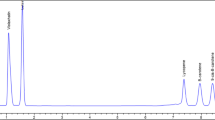Abstract
Bitterness is a major problem in the citrus industry worldwide, and is mostly due to the presence of limonoid compounds, especially limonin. In this study, the limonin content of orange juice concentrates from three active factories in west Mazandaran province, after reconstitution, was assayed using high-performance liquid chromatography (HPLC) and spectrophotometric methods. With HPLC, employing acetonitrile/water (v/v) (32:68) with a flow rate of 0.9 ml/min at λ=207 nm, the limonin content was in the range 11.7–23.3 μg/ml with a mean ± standard deviation (SD) of 18.5±3.6 μg/ml. Spectrophotometric measurement of limonin at 503 nm with Burnham reagent gave a range of 9.9–21.8 μg/ml with a mean ± SD of 17.16±4.1 μg/ml. The correlation coefficients of the detector linear response for the limonin standard (0–50 μg/ml) for HPLC and spectrophotometry were 0.995 and 0.989, respectively. The percentages of limonin recovery with and without sample addition were 101.02–111.40 and 93.0–100.8, respectively, for HPLC. The percentages of limonin recovery for the spectrophotometric method resulted in 95.6–101.8 for limonin-added samples. The precision factors for the two assay methods were ±2.10% and ±1.69, respectively. The correlation coefficient of the two methods was 0.84. Sensory evaluation of the reconstituted samples from the view point of bitterness confirmed 85% of the results of the analytical methods. This study recommends spectrophotometric analysis as a useful and suitable method for quantitation of limonin in the quality control laboratories of orange juice plants.



Similar content being viewed by others
References
FAO production yearbook (1999) Food and Agriculture Organisation, Rome
Agricultural Crops Statistics (2000) Ministry of Agriculture, Tehran–Iran
Annual Reports (2000) National Citrus Research Centre, Ramsar–Iran
Maier VP, Bennett RD, Hasegawa S (1977) In: Nagy S, Shaw PE, Veldhuis MK (eds) Citrus Science and Technology (vol 1), AVI Westport, Connecticut USA, pp 335–396
Maier VP, Hasegawa S, Bennette RD, Echols LC (1980) In: Nagy S, Attaway JA (eds) Citrus Nutrition and Quality. ACS symposium series (143), Washington, pp 63–80
Ozaki O (1995) J Food Sci 60:65–71
Puri M, Marwaha SS, Kothari RM, Kennedy JF (1996) Critical Reviews in Biotech 16:145–155
Berry SK (2001) Indian Food Packer 55:67–76
Hasegawa S, Berow MA, Manners GD (2000) In: Berhow MA, Hasegawa S, Manners GD (eds) Citrus Limonoids: functional chemicals in agriculture and food. ACS Symposium Series 758, Washington, pp 1–8
Pupin AM, Dennis MJ, Toledom MCF (1998) Food Chem 61:275–281
Puri A (1990) In: Rouseff RL (ed) Bitterness in Foods and Beverages, Elsevier Applied Sciences, Amsterdam, pp 325–335
Noomhorm A, Kasemsukakul N (1992) Intl J Food Sci Technol 27:65–73
Wilson KW, Crutchfield CA (1968) J Agric Food Chem 16:69–72
Fisher JF (1973) J Agric Food Chem 21:1109–1110
Johnson RL (1988) In: Linskens HF, Jackson JF (eds) Analysis of Non-Alcoholic Beverages, Springer, Berlin Heidelberg New York pp 80–101
Lancas FM, Galhiane MS (1990) J High Resolution Chromatogr 13:654–655
Tatum JH, Berry RE (1973) J Food Sci 38:1244–1246
Hasegawa S, Berhow MA (2000) In: Berhow MA, Hasegawa S, Manners GD (eds) Citrus Limonoids: functional chemicals in agriculture and food, ACS Symposium Series 758, Washington, pp 31–39
Mansell RL, Weiler EW (1980) Phytochem 19:1403–1407
McIntash CA (2000) In: BerhowMA, Hasegawa S, Manners GD (eds) Citrus Limonoids: functional chemicals in agriculture and food, ACS Symposium Series 758, Washington, pp 73–95
Jourdan PS, Mansell RL, Oliver DG, Weiler EW (1984) Anal Biochem 138:19–24
Manners GD, Hasegawa S, Bennett RD, Wong RY (2000) In: Berhow MA, Hasegawa S, Manners GD (eds) Citrus Limonoids: functional chemicals in agriculture and food, ACS Symposium Series 758, Washington, pp 40–59
Fisher JF (1975) J Agric Food Chem 23:1199–1201
Fisher JF (1978) J Agric Food Chem 26:497–499
Rouseff RL, Fisher JF (1980) Anal Chem 52:1228–1233
Shaw PE, Wilson CW (1984) J Food Sci 49:1216–1218
Shaw PE, Wilson CW (1988) J Chromatogr Sci 26:478–481
Widmer WW (1991) J Agric Food Chem 39:1472–1476
Manners GD, Hasegawa S (1999) Phytochem Anal 10:76–81
Manners GD, Breksa AP, Schoch TK, Hidalgo MB (2003) J Agric Food Chem 51:3709–3714
Widmer WW, Haun CA (2000) In: Berhow MA, Hasegawa S, Manners GD (eds) Citrus Limonoids: functional chemicals in agriculture and food. ACS Symposium Series 758, Washington, pp 60–72
Abbasi S, Zandi P, Mirbagheri E (1995) Proceedings of 9th World Congress of Food Science and Technology, Budapest, pp 151–152
Jellinek G (1985) Sensory Evaluation of Food: theory and practice, Ellis Harwood, Chichester, pp 252–288
Carter BA, Oliver DG, Jang L (1985) Food Technol 39:82–86
Guadagni DG, Maier VP, Turnbaugh JG (1973) J Sci Food Agric 24:1277–1288
Kimball DA (1991) Citrus Processing. van Nostrand Reinhold Co, New York, pp 136–161
Acknowledgements
We thank Dr. Widmer (Florida Citrus Department) for donations of pure limonin and nomilin standards. We also appreciate the help and cooperation of the managers of the citrus processing companies in west Mazandaran in sampling and sharing their opinions.
Author information
Authors and Affiliations
Corresponding author
Rights and permissions
About this article
Cite this article
Abbasi, S., Zandi, P. & Mirbagheri, E. Quantitation of limonin in Iranian orange juice concentrates using high-performance liquid chromatography and spectrophotometric methods. Eur Food Res Technol 221, 202–207 (2005). https://doi.org/10.1007/s00217-005-1136-1
Received:
Revised:
Published:
Issue Date:
DOI: https://doi.org/10.1007/s00217-005-1136-1




